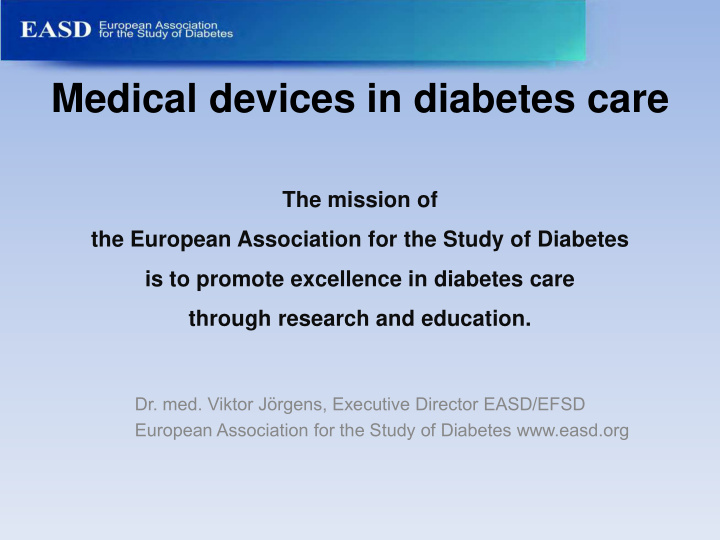



Medical devices in diabetes care The mission of the European Association for the Study of Diabetes is to promote excellence in diabetes care through research and education. Dr. med. Viktor Jörgens, Executive Director EASD/EFSD European Association for the Study of Diabetes www.easd.org
What is the European Association for the Study of Diabetes? Founded in 1965 Based in Düsseldorf, Germany Academic non-profit organisation The Official Journal of the Association is Diabetologia Conducts numerous Postgraduate Education Courses Our Foundation, EFSD, has donated €90 million Annual Meeting with 18,000 delegates from 120 countries
Medical devices in diabetes care Regretfully, in the past, EASD was not sufficiently active in the area of medical devices. We hope that in the future closer collaboration between academic medical societies, regulatory bodies and industry will improve care and protect the health of millons of people with diabetes.
Insulin pumps of the 1970s & 1980s Simple technology No software control No or few alarms No wireless connectivity Used experimentally or for limited routine clinical care Little or no pre-market testing or regulation of pumps
Insulin Pump Therapy 2013 Complex, sophisticated technology Many alarms for malfunction Onboard software, bolus calculators etc. Wireless connectivity with BG meters, computers etc. In widespread use
Pumps failures still occur Isabelle Guilhem et al., Diabetologia 2009; 52: 2662-4 2001-2007, survey of 640 new pumps from 4 manufacturers Any defect: 36% of pumps Complete pump failure: 16% of pumps Mechanical defects requiring replacement: 6.5% of pumps
No large, independent, systematic survey of technical, non-metabolic complications of CSII since 1980s Are modern pumps safer and more reliable than in the1980s? Are there less complications? Lack of research data to claim for reimbursement Presented by Prof. J. Pickup, EASD 2013 in Barcelona
Device research is underrepresented in the EASD scientific meeting 1360 abstracts accepted for presentation in the 2013 EASD Meeting attended by 18,000 diabetologists Only 42 abstracts accepted on medical devices Only 3% of the scientific presentations Actions are urgently needed to increase research into this area
Position of the EASD
Dr. Deborah Cohen from the Department of Investigative Journalism at the British Medical Journal giving her lecture in the EASD Annual Meeting in Barcelona on medical devices. Research on Medical Devices needs more publicity in academia!
The new annual EASD Diabetes Technology Conference will provide a top-level forum for research into devices in diabetes care and will unite all stakeholders to discuss worldwide regulatory issues.
EASD / ADA Statement on Insulin Pumps A committee of experts was nominated by EASD and the American Diabetes Association to compose a joint statement on the evaluation of insulin pumps to be released in 2014.
Continuous glucose monitoring CGM Most data on efficacy and safety comes from, a small few, clinical investigators Insufficient systematic monitoring of adverse events
The future: the Artificial Beta Cell Modern diabetes technologies are becoming ever more sophisticated – hopefully providing a closed loop system in the future. Assessment and regulation of quality will become increasingly more complex, demanding and expensive It cannot be left to manufacturers, ‘Notified Bodies’ or ad hoc academic reports.
European academic medical societies should collaborate with strengthened regulatory bodies and industry concerning medical devices. The aim is to provide patients with safe and effective modern technology for better care.
Recommend
More recommend